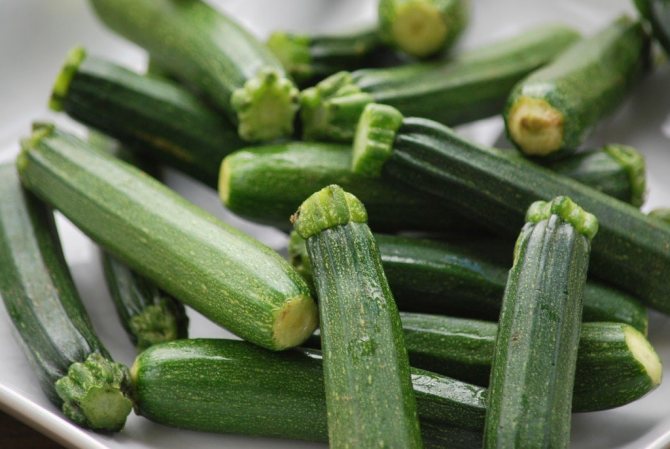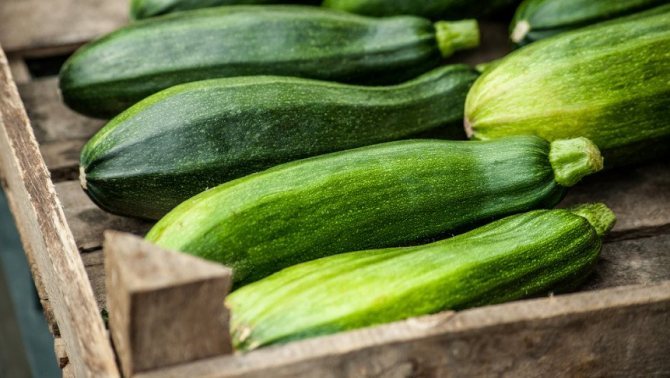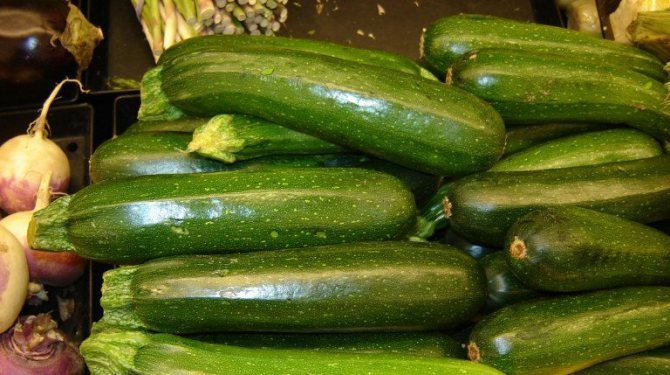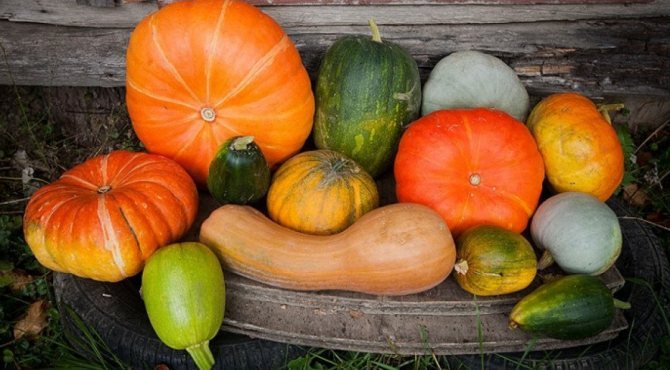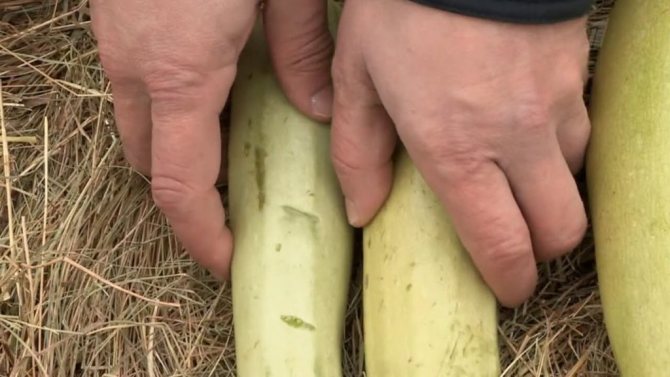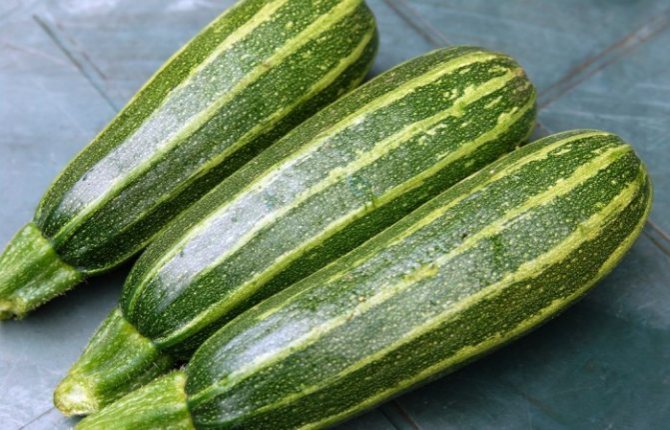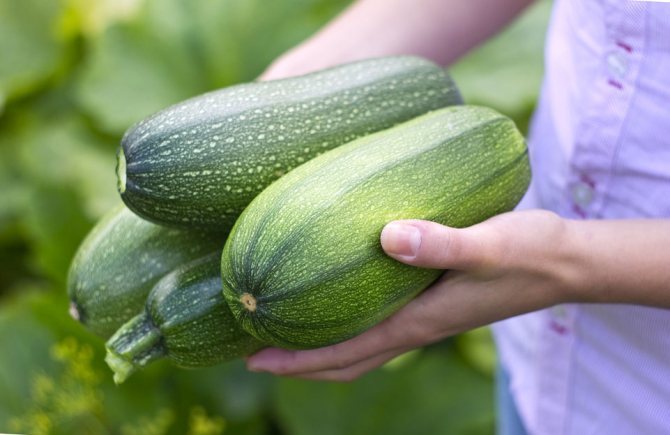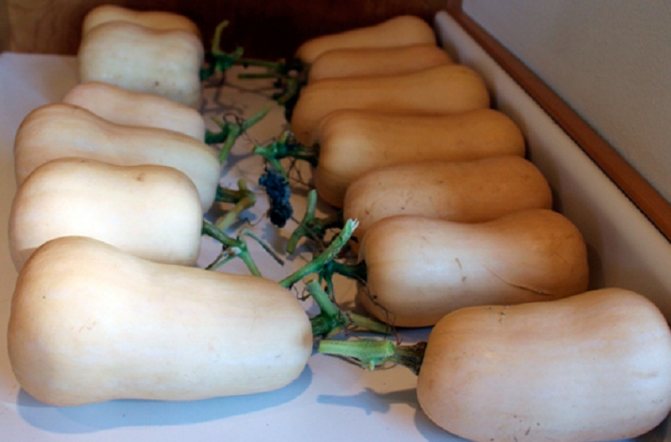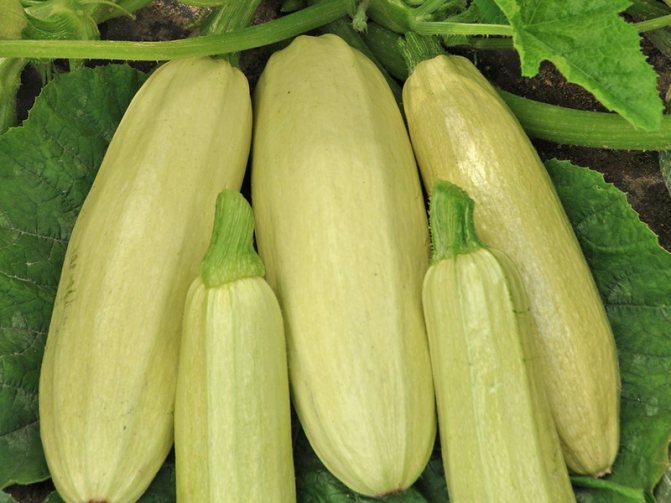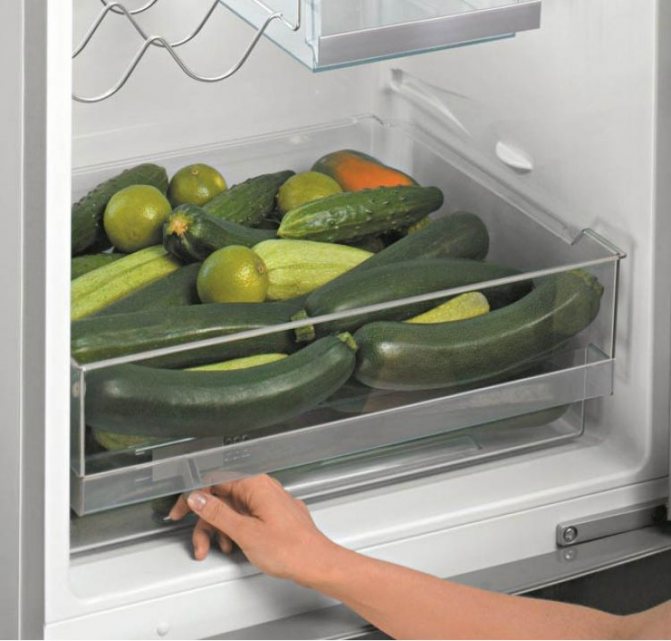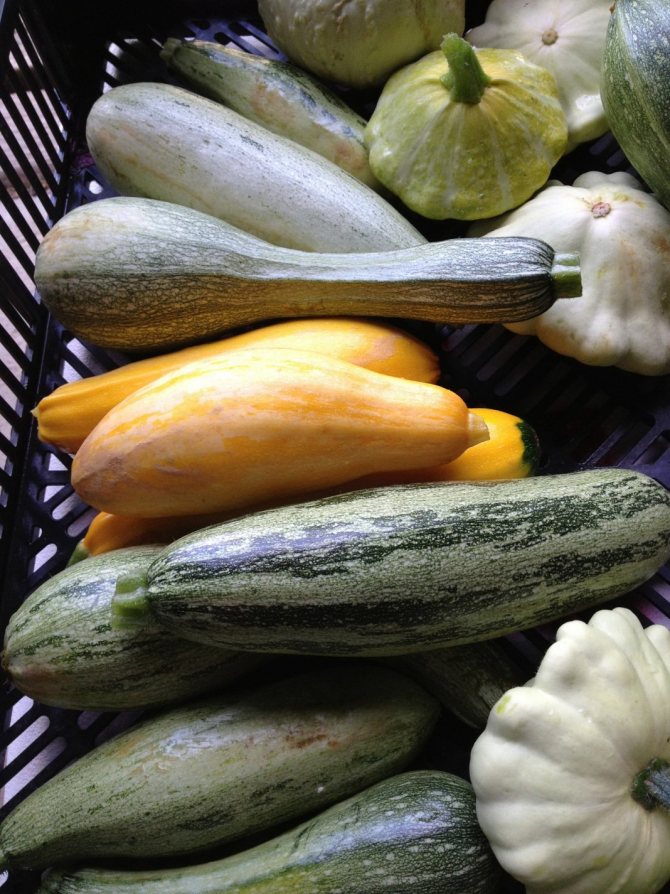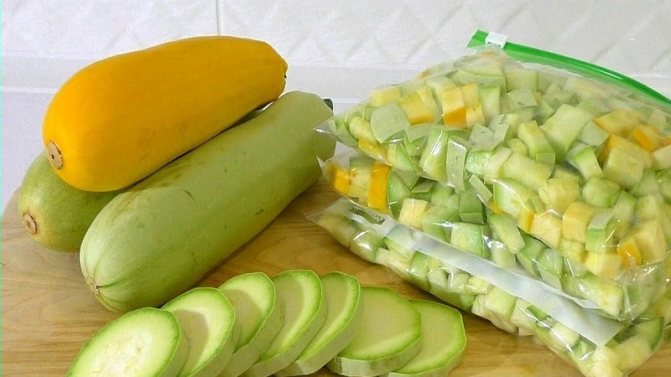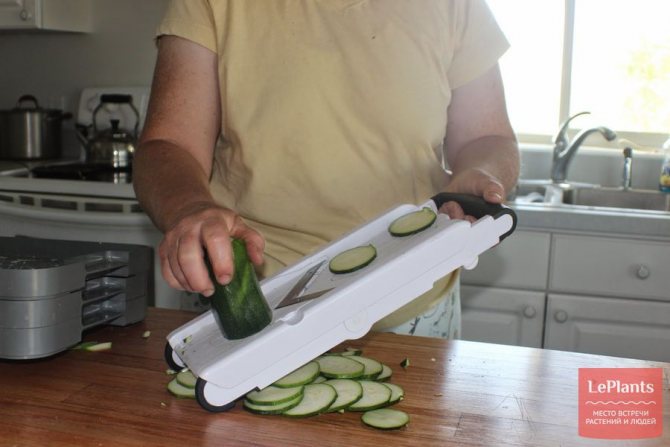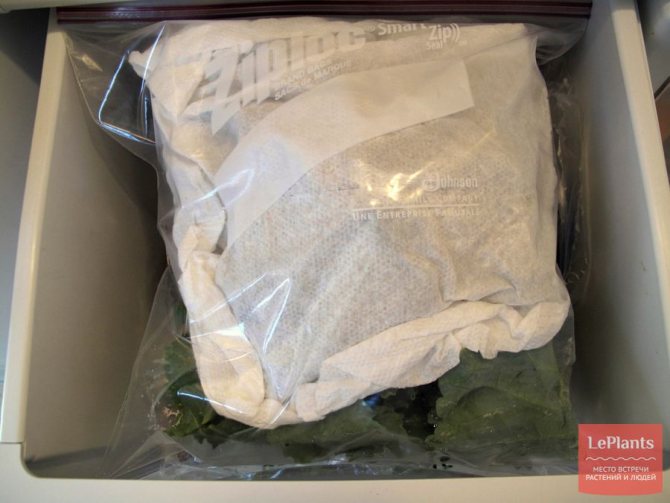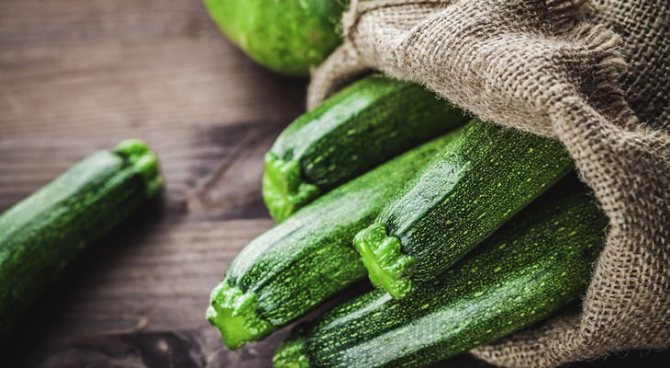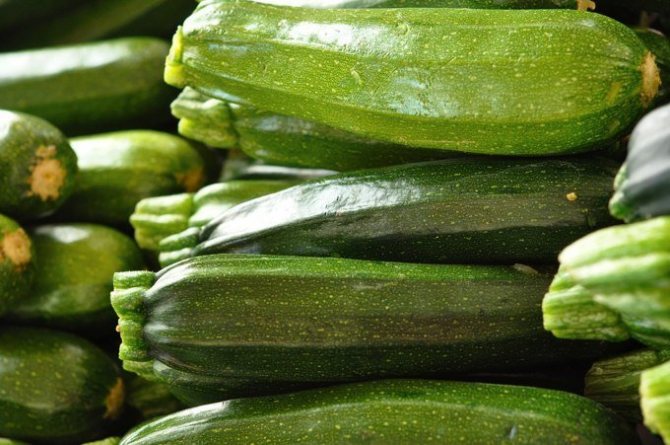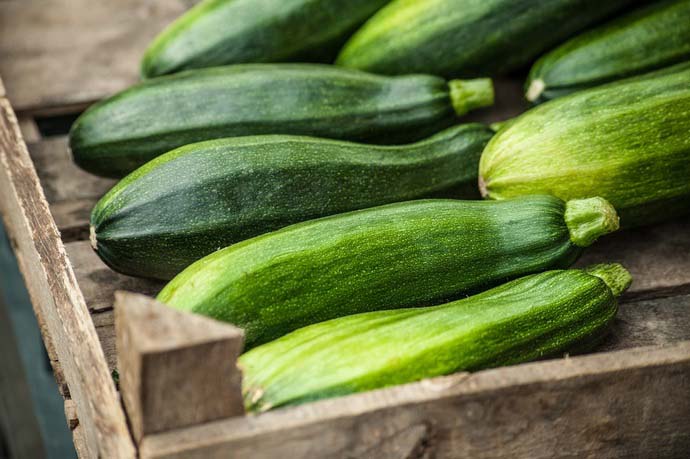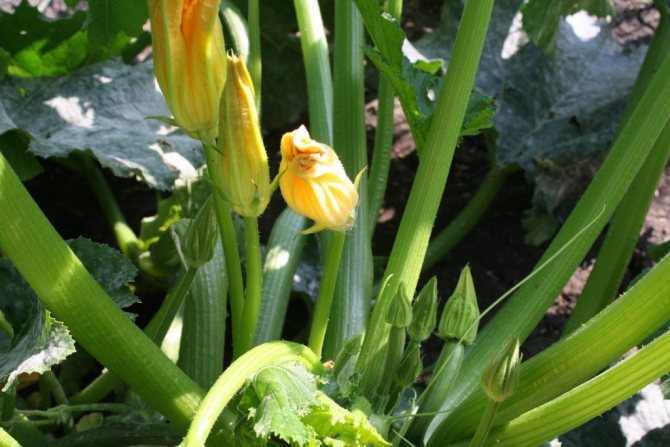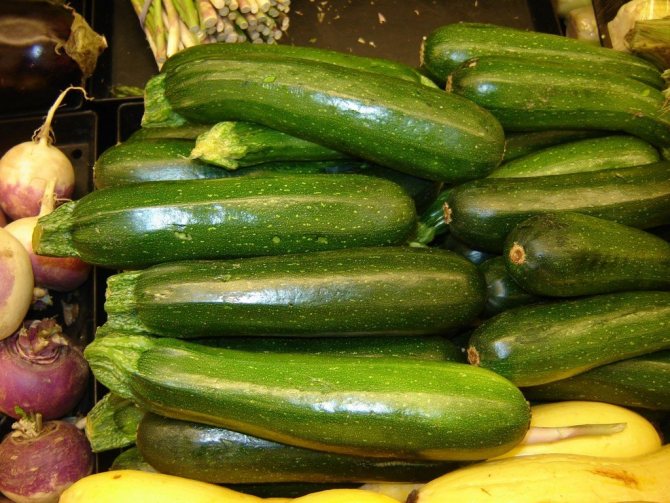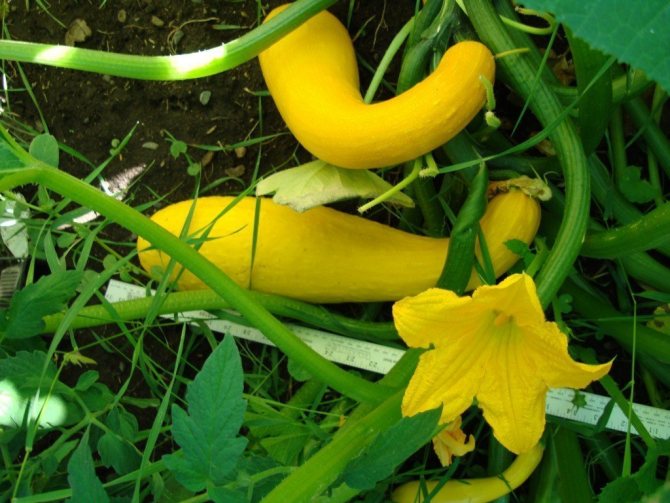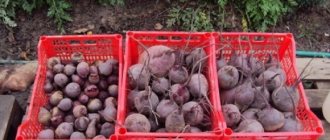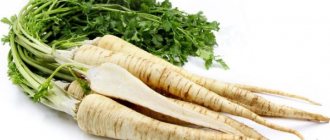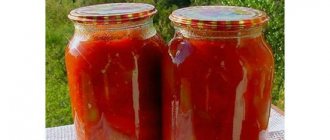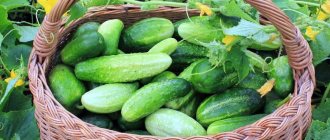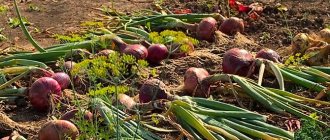Zucchini, although they belong, like pumpkin, to the pumpkin family, the conditions for their storage have both many common, key points, and many differences. Zucchini and pumpkin can be stored together if the vegetables are intact, without damage, without signs of decay and collected on time: they will not interfere with each other during storage and there is no risk that the disease will spread from pumpkin to vegetable marrow and vice versa. However, it has been noticed that pumpkins usually lie much longer than zucchini, which is important to take into account when storing the fruits of these vegetable crops together and check their storage places at least once every couple of weeks, since if the zucchini begin to rot, then the rot can quite easily spread to the pumpkins.

Storing zucchini harvest in the house. <>
In addition, it is reliably known that pumpkins can be stored at a significantly higher temperature than marrow.
Naturally, a long period of preservation of both pumpkin and zucchini can be ensured if the harvesting technology, its preparation for storage and the storage conditions themselves, which are specific for the fruits of each of these crops, are correctly observed.
Important! Do not "overexpose" the fruits in storage, try to use them as food as soon as possible. The longer pumpkins and zucchini are stored, the rougher they become, some of the nutrients are lost, and they can begin to deteriorate at any minute, then all your work will literally go to waste, do not forget about it.
So let's start with how to properly store zucchini at home and then talk about pumpkin.
Choosing the right varieties
Such vegetables can be stored fresh for the winter for a long time without problems, but only on condition that the temperature regime, humidity, and storage location are observed. Zucchini are popular for their high yields. This means that you can cook a huge number of seams, and also keep them fresh for the winter for a long time.
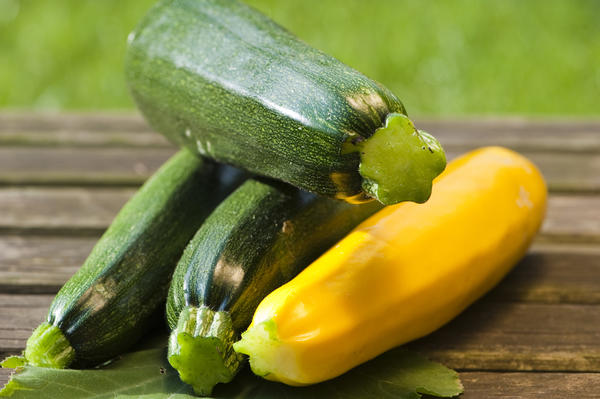

However, not every variety is suitable for winter storage. Keeping quality mainly depends on the selected variety. If the summer resident wants to keep the zucchini fresh for a long time, then special attention should be paid to the choice of seeds.
Mid-season and late-ripening varieties are preserved the longest. Early ripe ones are suitable for canning and cooking for several months. It is unlikely that it will be possible to save them for the whole winter.
Also, zucchini should have a thick skin and small seeds. Modern breeders are trying to breed such hybrids in order to prolong the life of fresh fruits.
Long-lived zucchini include:
- Arlika F1;
- Asset F1;
- Negro child;
- Yellow-fruited;
- Anchor;
- Watermelon;
- Aeronaut;
- Pear-shaped;
- Aral F1;
- The festival;
- Gold Cup;
- all varieties of zucchini.
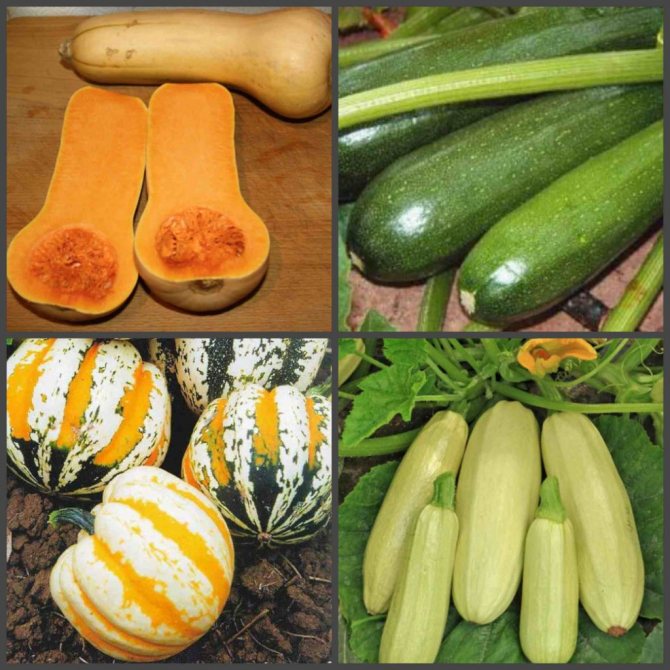

How to store zucchini at home in an apartment
In the absence of a basement, vegetables are stored at home or in an apartment. The living room is always at a constant temperature, low humidity. The main thing is that there should be no heating devices nearby. The fruits are well stored in a dark room, so they are simply folded in the pantry, under the bed, in the sofa.
Having properly prepared the fruits for storage, some varieties of zucchini can be stored until the new year, or even longer. The optimal shelf life for zucchini is 4-5 months. It should be noted that zucchini stored for a long time become not so tasty and juicy.They become rough or, conversely, too soft. And their nutritional value also decreases over time.
An important stage is the collection and selection of the crop
Harvesting must be done even before the onset of cold weather. It is important that the temperature is kept above freezing. Frozen vegetables have a short shelf life. Fruits that turned out to be at least slightly deformed: with cracks, dents, blackening - quickly deteriorate.
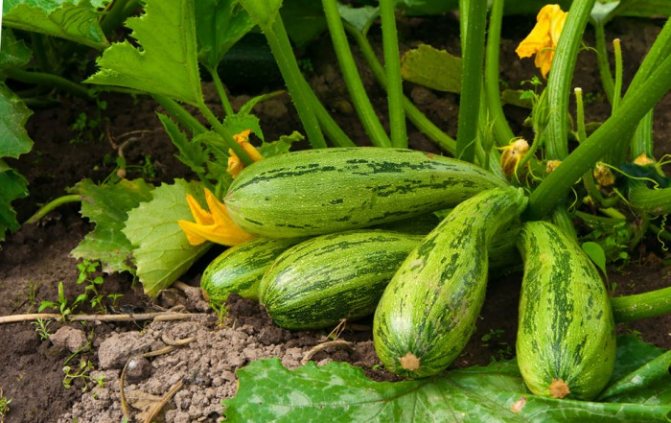

Harvesting rules:
- The maturity of the squash is determined by its appearance: by color and size, depending on the selected variety.
- You can tactilely determine the maturity of the crop... The vegetable is dense, its skin is thick, a dull sound is heard when tapped.
- Mature zucchini should have a ripe stalk... Only the overripe fruit should not be allowed, otherwise keeping quality and taste characteristics are reduced.
- You need to cut the fruits carefully with a garden knife.so as not to damage the fetus. Leave the leg at least five centimeters. After a while, it will dry out and protect the fetus from infection. The size of the vegetable should be between 20-40 cm.
- Harvesting must be completed before the first frost... The harvested fruits are recommended to be left in the fresh air under the sun's rays to dry. Put on film or in boxes in one layer and leave in the open air for 3-4 hours.
Important! You can not wet the crop with water. Medium-sized fruits reach a length of 20 cm. They are used for stewing, pickling, salads, they have small bones and soft pulp. Large specimens are recommended to be left for stuffing and stews.


Processing technology is carried out immediately after drying. It consists of the following stages:
- Clean the vegetable from dirt, sand. It is important not to damage the zucchini rind.
- The vegetables should be sorted by examining each one individually. If there is damage to the root crop, then they should be used first.
- Choose medium-sized fruits for long-term storage, and use large fruits in the first months.
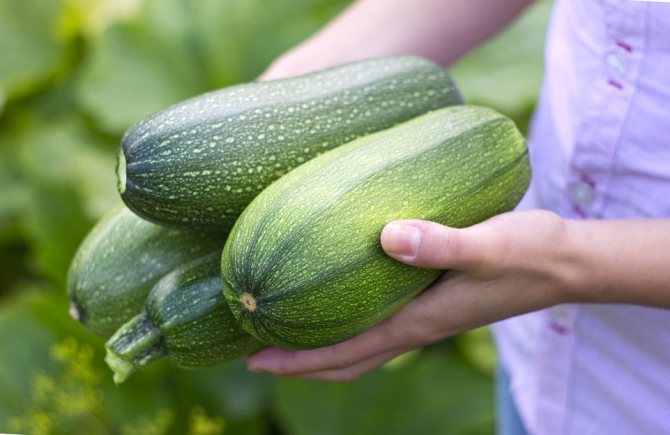

Interesting! The storage of zucchini can be designated as a separate item. Many summer residents attribute this type of zucchini to long-livers. For harvesting, fruits with a hard skin are chosen.


How to prepare zucchini fruits for storage
So that you can store zucchini for a long time in a cellar or apartment, you need to properly prepare them. This work must be done as efficiently as possible, since the shelf life of the product harvested for the winter depends on it.
Algorithm of actions:
- They collect zucchini from the garden or buy them at the market.
- The fruits are sorted out, getting rid of all damaged and withered specimens.
- Selected vegetables are cleaned of dirt and adhering plant debris. This work must be done as carefully as possible so as not to damage the delicate skin. At the same time, it is forbidden to wash the fruits with water.
- Zucchini are laid out in the sun and kept for 24 hours.
- After that, the vegetables are placed in the selected container and placed in the prepared room.
During the preparation, it is necessary to take into account several important recommendations. They will help you avoid mistakes and increase the shelf life of vegetables.
Important nuances:
- At the sorting stage, you need to get rid of the frozen zucchini. Even if properly prepared, they will not last until winter.
- Overripe vegetables will lose some of their beneficial properties and their shelf life will be reduced several times.
- Zucchini with a length of 15 to 45 cm are suitable for harvesting for the winter.
- For storage, you need to choose fruits with a high-quality stalk. It should be trimmed, leaving at least 5 cm. During storage, this part of the vegetable will protect it from the penetration of various infections and harmful microorganisms.
Necessary storage conditions
You can store zucchini at home as follows:
- canning;
- freeze;
- leave fresh.
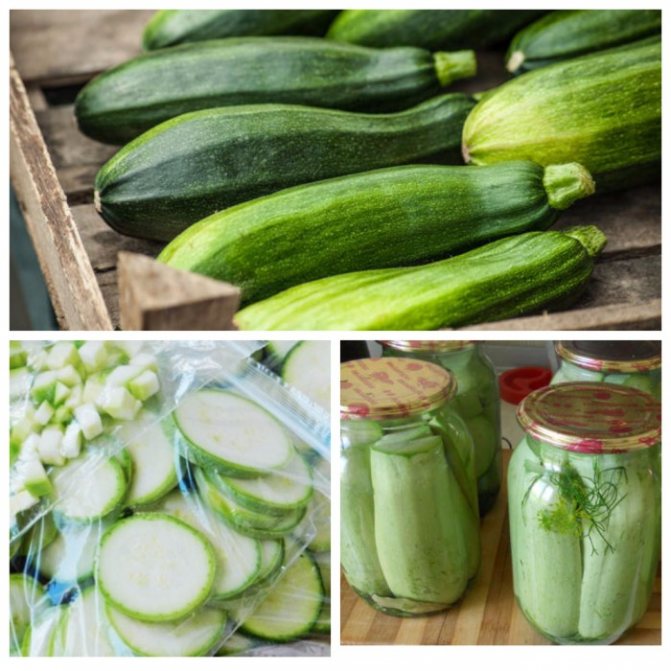

Let's consider in more detail the option with fresh storage!
Zucchini are not very demanding vegetables, this fact allows you to keep the crop fresh even in the absence of special premises. However, it is important to create a comfortable environment for them.
To keep zucchini at home in winter, you need to adhere to the following rules:
- Take care of the storage temperature of the crop... Zucchini is suitable for t + 4 + 10 C.
- Humidity the premises should be no more than 90%.
- Ventilation of the room... There must be a possibility of free passage of fresh air.
- Container... You can store zucchini for the winter in boxes, boxes. The fruits should not rub against each other. It is also recommended to wrap each fruit individually with paper. For a large number of fruits, this method is problematic to implement, so you can put a cardboard partition between the fruits.
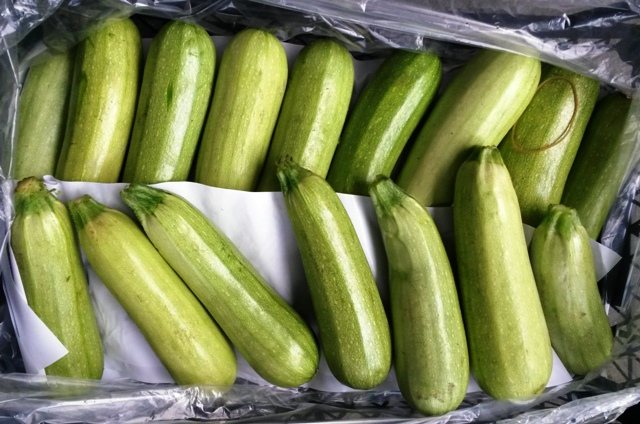

Fresh storage methods
There are a few easy ways to preserve your squash before processing. To a greater extent, they are suitable for a private house, but they can also be used in an apartment. Choose which one suits you best.
- On racks or wooden pallets. Vegetables are placed in one row, after having laid straw, hay or thick paper under them. The fruits are laid so that they do not touch each other.
- In the boxes, the stalks are up. In order to protect the fruits from contact, cardboard and cloth are laid between them. You can also wrap each piece in paper to further protect the vegetables from accidentally dropping temperatures.
- In vegetable nets, which are hung on hooks in the cellar. As practice shows, this is a reliable way to keep fresh zucchini in winter.
Check the bookmark regularly for damage. Dispose of rotten or lethargic specimens immediately.


You can recognize damage in time by a rotten stalk.
We answer the question: Why are fresh-stored zucchini bitter?
There are many reasons for bitterness. The main one is that this is a normal spoilage process, since this vegetable is not stored for fresh food.
You can get rid of the bitter taste by keeping the zucchini cut for cooking in a salty solution (2 tablespoons of salt per 1 liter of water) for 30-40 minutes. However, the taste has already been lost, and you need to try very hard to make a culinary yummy from such a product.
General Tips
In order for the fruits to delight with their taste and benefits, it is important to properly store the zucchini at home. This will help you recommendations from experienced gardeners that must be followed:
- By the beginning of spring, the remaining fruits should be used for food. If there is too much crop left, it is recommended to peel it, grate it and freeze it.
- Zucchini rotting occurs precisely from the tail. It is recommended to dip it into melted paraffin or wax before storing.
- Place fruits in a box previously covered with sawdust or straw.
- Do not leave crops near heating appliances.
- When space is limited, crops can be stored in crates and boxes and stored under the bed.
- Young and overripe fruits are suitable for freezing.
- When buying zucchini at the store, it is best to opt for small to medium sized fruits with a bright green rind. They last longer. Large varieties are grown for stuffing.
- Overripe courgettes should be used first, especially if they are loose or wrinkled.
- Before cooking, zucchini should be washed and cleaned of dirt, cut off damaged areas. It is not recommended to cut off the peel completely, as it contains a huge amount of vitamins.
- Alternatively, you can hang the zucchini in mesh bags. If one fruit begins to rot, it will not affect the others.
When to collect?
When to store zucchini for the winter? Squash harvesting should be planned before frost.... Otherwise, if they get frozen, the vegetables will be hopelessly spoiled for long-term storage - they will begin to rot in the near future, and it will not be possible to save them.
Suitable for harvesting vegetables that have:
- a sufficiently thick skin, which, when tapped on it, emits a dull sound;
- incompletely developed seeds;
- medium sizes;
- free from damage and developmental defects;
- all specimens must have a clearly defined pattern typical of the class.
During storage, zucchini ripen additionally, and fully ripe specimens will have a loose structure. In addition, it is possible for seeds to germinate in such specimens inside a vegetable that has been laid for long-term storage.
Vegetables should be cut, leaving 4-5 cm of stalks... The stalk should have a clear cut, not be divided into several parts - this happens if the vegetables are simply plucked by twisting.
We recommend: How to freeze gooseberries for the winter: 4 ways
Smoothly cut and having a sufficient length of the stalk allows you to close the entrance to the courgette for various microorganisms that cause rotting.
In addition, by how much the stalk is preserved, the vegetable grower can track whether the vegetable has deteriorated. If the edge of the stalk begins to rot, you must eat the zucchini..
The collection should be carried out in dry weather, being careful not to damage the skin of the vegetables. Zucchini cannot be washed, this will lead to the development of decay processes, it is enough to simply wipe them off with a dry cloth from the remnants of the earth. After harvesting, vegetables must be dried in a well-ventilated place. - it is enough to arrange them in one row in boxes or on boards for several hours.
Features of storage locations
Zucchini are popular not only for their tasty and healthy pulp, but also for their excellent keeping quality. You can keep the zucchini fresh for the winter both in a private house and in an apartment. Let's consider both options in more detail.
In the apartment
It is very important at what temperature you will store the zucchini in winter. Due to the fact that the vegetable is suitable for a temperature of +10, it can be stored in an apartment environment.
In order to normally keep zucchini for the winter in an apartment, you must follow the rules:
- Storage is carried out in a dry, dark place: under the window, on the balcony, in the closet, in the refrigerator. It is important to keep the vegetable in the dark.
- At room temperature, you can keep zucchini for the winter in an apartment for no more than 3-4 weeks. And at t 4-12 C, vegetables can lie for 2-4 months.
- Vegetables should be kept separately. Therefore, storage in bags, bags is not suitable. If there is not enough space, but there are a lot of fruits, then you need to separate them with a partition.


Places in the apartment where you can store zucchini:
- Balcony or storage room... If the balcony is insulated and room temperature is maintained on it, then at this temperature it will be quite problematic to keep the zucchini for longer than a month and a half. If the balcony is cool, then the fruits will lie like in a cellar. Better to put vegetables in wooden boxes or on shelves lined with paper.
- Refrigerator... Although this is a rather limited space to store a lot of fruit, a couple of copies can be placed. You can store zucchini in the refrigerator for no more than 2 weeks, because the fruit will not lie due to the high humidity. The decay process may begin. It is better to fold the fruit in a paper bag with pre-made holes for ventilation.
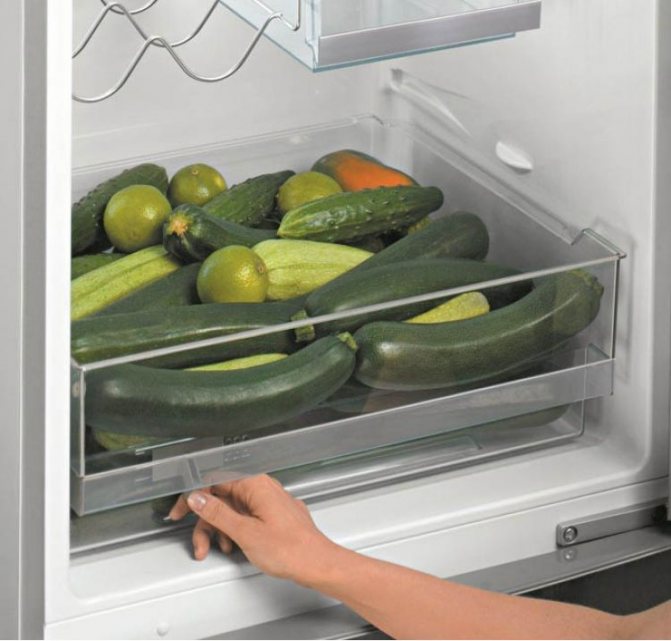

- Under the windows... If there is no balcony in the apartment, then you can store the zucchini in the apartment right under the windows, just not near the battery. It is convenient to put fruits in boxes. The main thing is to ensure that the container is darkened from light.


In a private house
As a rule, keeping zucchini fresh for the winter in a private house is not difficult. There are enough places for this.
Without a doubt, the best place to store zucchini for the winter is in the cellar (basement). But you can put the crop in an insulated barn or in another room in the house.The place where the zucchini will be stored must meet all sanitary requirements.
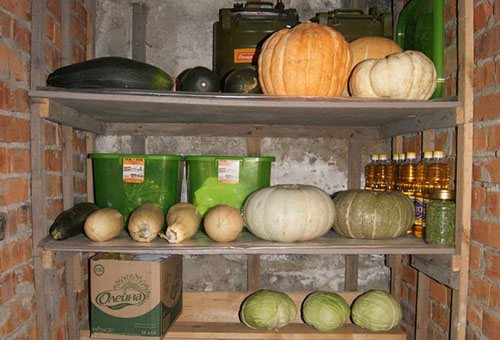

Consider the parameters of the cellar in which you can store zucchini for the winter:
- The room must be clean, dry and maintained at a certain t mode. There should be no mildew, mold, too high humidity. You also need to take care of cleaning the room from rodents and insects. After pickling the pests, a general cleaning should be done.
- The cellar or basement in which you will store zucchini for the winter should be well ventilated, and protection from groundwater should also be provided.
- Ideal t + 4 + 10 C.
Video: how to keep zucchini fresh for the winter at home.
When the cellar meets these requirements, you can move the zucchini there and store for the winter:
- It is most convenient to organize special racks or boxes.
- It is recommended to put sawdust and hay on them.
- The fruits should not be rubbed, it is also necessary to provide that moisture does not get under them.
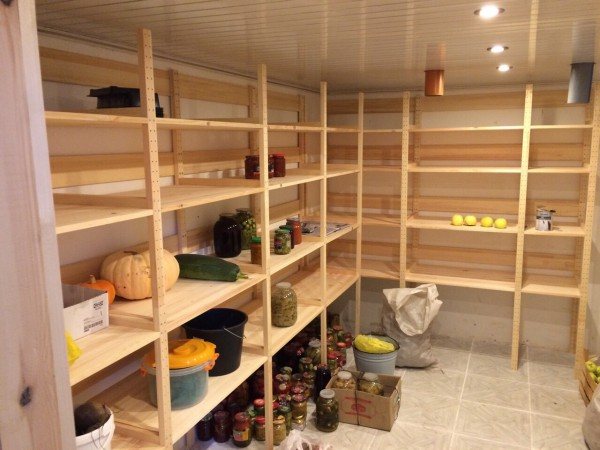

If you store zucchini in a cellar in winter, taking into account the above rules, then you can save the vegetable until spring. However, with a change in t and the arrival of heat, the seeds in the zucchini begin to sprout, which spoils the vegetable. It is better to use it for its intended purpose until this time.
Interesting! Ordinary chalk or ash can be an assistant in this matter. To do this, sprinkle them with chalk or ash when placing the fruits in the cellar or basement.
Video: how to store zucchini at home.
What varieties of zucchini are suitable for winter storage
Before planting vegetables in the garden, you need to determine which varieties of zucchini will best tolerate long-term storage. Experts recommend that beginners choose vegetables with a rough surface layer, dense texture and as small seeds as possible.
To keep fresh zucchini in an apartment or a private house for a long time, you must choose one of 7 varieties. Among them there are:
- Aeronaut. It grows quickly and tastes good. You can pick vegetables as early as 1.5 months after the sprouts appear. Ripe fruits are cylindrical and have a dark green skin. The weight of one vegetable does not exceed 1.5 kg.
- Pear-shaped. This early variety gets its name from the shape of the fruit. It is distinguished by its bright yellow pulp, which has a specific aroma and excellent taste. At the time of ripening, the fruits can weigh from 1 to 1.5 kg.
- The festival. What makes this variety special is its spherical shape, which is why squash is often confused with pumpkin. The rough, striped skin of the vegetable can be yellow, green, and white. The fruits of this species are distinguished by their large weight, reaching 3 kg.
- Arlika. One of the most common varieties is cylindrical in shape. Its dense, but not too rough skin is colored in light green tones. Arlica's weight rarely exceeds 1.5 kg.
- Negro child. The main distinguishing feature of this variety is its high yield. According to this indicator, Negritok is superior to most other varieties of zucchini. Vegetables weighing up to 2 kg have a dark green skin and a dense pulp texture.
- Yellow-fruited. This variety of zucchini is similar to Arlika. The only difference is the bright yellow color of the skin, which is formed due to the high concentration of carotene. These vegetables weigh only 1-1.2 kg, but taste great.
- Anchor. It stands out from other varieties for its light yellow fruits and thin and smooth skin. Ripe fruits have few seeds.
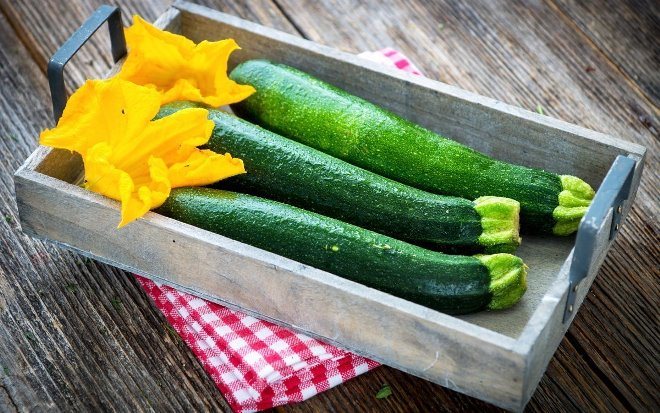

Other ways to save
There are other ways to preserve the harvest as follows:
- Freezing... If space permits, then you can cut the zucchini into pieces and store it cut in the freezer for the winter. To do this, the fruits are thoroughly washed, peeled, cut into slices and frozen in a container or plastic bag. If the fruits are young, then the peel can be left.If you keep the zucchini in the freezer for the winter, then in the future they can be used to prepare various dishes.
Video: how to freeze and store zucchini for the winter in the freezer.
- Canning... You can prepare various salads, stews, caviar, pickles and even marrow jam and roll up the fruits in glass jars. Thus, the "life" of the vegetable will last until the next season.
Video: how to preserve zucchini for the winter.
Important! Regardless of the storage location chosen, vegetables should be checked regularly for rot. You can recognize the beginning of the process by the tail (it is with it that rotting begins).
If the fruit is very dark and shriveled, then you need to remove it from the storage place. Otherwise, it will infect other fruits. Sprinkling chalk on the crop will protect it from rot. The procedure should be performed once every 10 days.
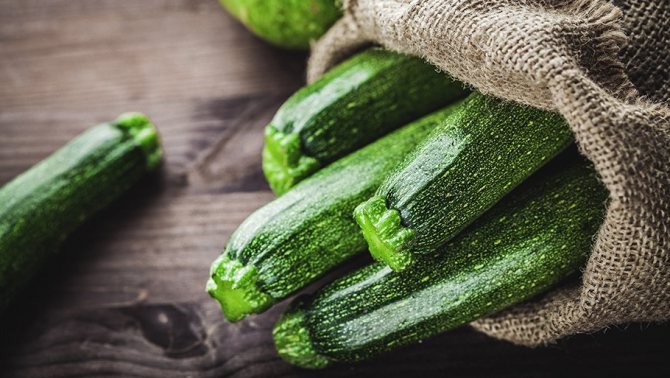

Preparation
The skin of long-term zucchini should be thick and firm to protect the fruit from rotting. There should be no damage on the surface of the peel. Scratched zucchini are best eaten immediately after harvest.
You need to collect vegetables from the garden together with the stalk, cut off by 6-9 cm. It protects from putrefactive processes and drying out of the pulp. The quality of the fetus is determined by the condition of the leg. If it is firm, the zucchini can still be stored. Fruits with soft legs will not last long, they must be eaten immediately.
Fruit selected for stocks must not be washed. They are wiped off the ground with a dry cloth, dried from moisture. The fruits are stacked vertically in a regular wooden box, legs up, in one or more layers. In the intervals between the rows, clean sheets of cardboard are laid.
Typical mistakes
You can save zucchini at home in winter without costs and problems. However, there are several popular mistakes that some summer residents make when storing a vegetable:
- Young zucchini of milky ripeness will not be stored for a long time, although they are tasty. Maximum will withstand 2 weeks.
- Cut fruits without a stalk deteriorate very quickly, being affected by putrefactive bacteria.
- Storage on a cold balcony can lead to frostbite of the fruit, the skin will begin to darken, and the zucchini will lose its flavor.
- After harvesting, do not rinse the fruit in water.
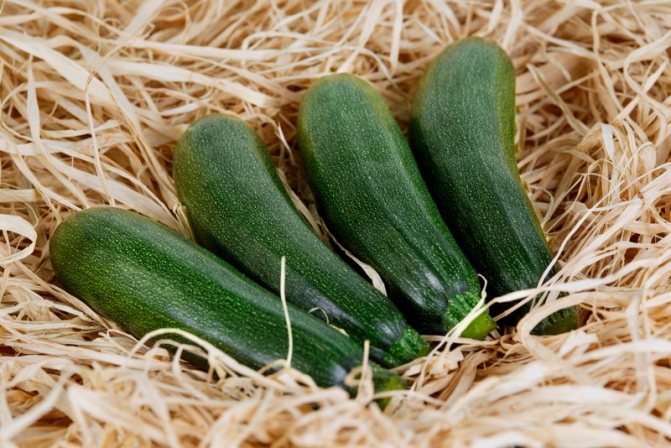

This amazing vegetable can be used to make a variety of dishes, twists, salads, and even use to make sweet jam! That is, the use can be varied, as well as ways to save it.
It is certainly nice when, on cold snowy days, you can enjoy a healthy and mouth-watering vegetable. And if you follow the storage conditions of the vegetable, then you can eat dishes with it all winter. The main thing is to choose the right variety from the beginning and decide in what way the zucchini will be preserved: fresh or seaming, freezing. Good luck!
Helpful hints
A good solution for winter storage is a wooden trellis box with a layer of sawdust on the bottom. If there are no wooden boxes, ordinary cardboard boxes can be used. It is advisable to store full boxes on wooden shelves closer to the ceiling. Before laying vegetables, the shelves are covered with dry straw or paper. When using any of these methods, it is important to remember that zucchini is best stored in the upper part of the cellar (under the ceiling).
Did you know? Zucchini contains much less water than cucumber, but much more vitamins and minerals. The vegetable contains vitamin C, folic acid, potassium, calcium, manganese, magnesium, phosphorus, selenium, and zinc.
For some time, it will be possible to preserve only uncut fruits, as a whole - this is the main condition for their long-term preservation. A cellar or basement will help extend the season for eating zucchini for a few more months. For the success of this enterprise, it is important to correctly lay these vegetables in the cellar and, of course, observe the temperature regime for their storage.



